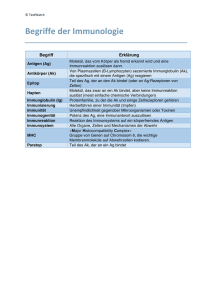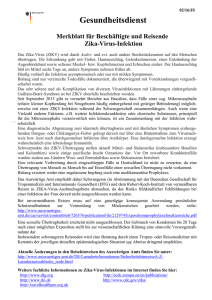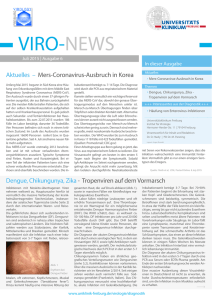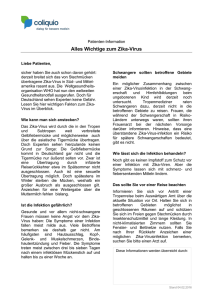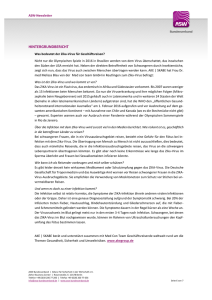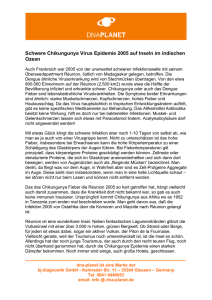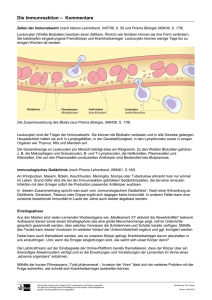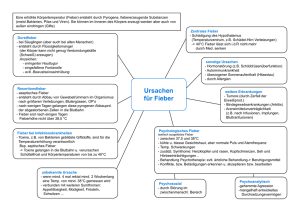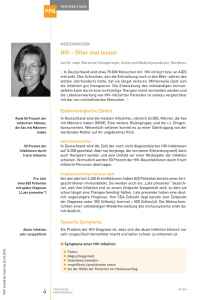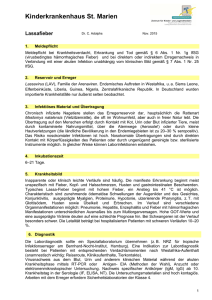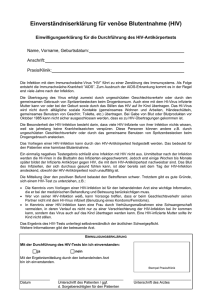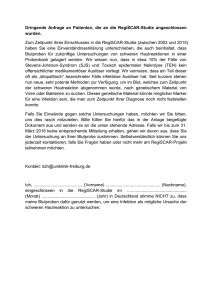Fieber 70j. Mann zurück aus Kambodscha
Werbung
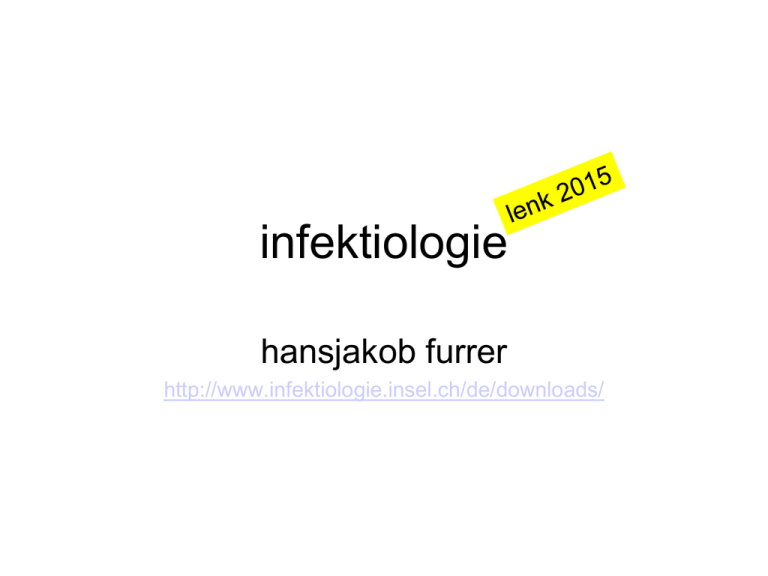
infektiologie hansjakob furrer http://www.infektiologie.insel.ch/de/downloads/ Ambulant erworbene Pneumonie 1. Wo behandeln 1. Ambulant 2. Hospitalisation 3. Hospitalisation dringend 2. Wie behandeln Wo? Prim Care Respir J. 2010 Mar;19(1):21 BTS 2015 Was? IDSA 2007 UK 2010/15 Insel Ambulant Makrolid Doxycyclin Amoxicillin (Clarithro, Doxycyclin) Amoxicillin oder Co-Amoxi (Clarithro, Doxycyclin, Moxifloxacin) Ambulant + Komorbidität Respirat. Chinolon Beta-Lactam + Makrolid Stationär nicht IB Respirat. Chinolon Beta-Lactam + Makrolid Amoxicillin oder Co-Amoxi +/- Makrolid (Moxiflocacin) Dito Co-Amoiy oder Amoxi Ceftriaxon +Makrolid +/- Makrolid Respirat. Moxifloxacin Chinolon Cephalosporin + Claritho Wie lange Antibiotika? • Ca 7 Tage • Bei schnellem Ansprechen kürzer – Afebril – AZ • Kompliziert, schwer: 7-14 • Länger bei Abszessen Erreger (Blum Lancet 2015) Erreger (Postma NEJM 2015) sensitive cell wall: transpeptidase Tigecycline Fol.synthesis Co-trimoxazole cell wall Vancomycin cell membr. Daptomycin Ribosome Linezolid Nucleic acid Ribosome Metronidazole Doxcyclin Ribosome Clarithromycin Ribosome Clindamycin Ribosome Aminoglycosides Nucl.acid DNA Gyrase Ciprofloaxcin Moxifloxacin Atypical Ribosome Difficult anaerob. Ertapenem Easy anearob. Imi-,Meropenem synergism ESBL Piperacillin-Tazobac. P.aerug. Cefipime Difficullt gram- Ceftazidime resistant Easy gram- Ceftriaxon H.infuenz. 2nd Gen Ceph MRSA 1st Gen Ceph CN Staph Flucloxacillin S.aureus Co-Amoxiclav Enterococ. Penicillin Pneumoc. per os formulation available Streptoc. Drug partly, emerging resistance Postma NEJM 2015 Cluster Randomized Trial Beta-Lactam Beta-Lactam + Makrolid Mortalität nach 90 Tagen Chinolon Postma: Mortaliät 90 Tage Postma: Mortaliät 90 Tage vgl mit Beta-Lactam solo Ambulant erworbene Pneumonie -> Hospitalisation Antibiotika + Placebo 393 Antibiotika + 50mg Prednison für 7 Tage 392 1. Klinische Stabilität 2. Hospitalisationsdauer 3. ….. Klinische Stabilität Für mindestens 24 h: • • • • • • • Temp < 37.8 Hf < 100 Atemfrequenz < 24 BD systolisch > 90 Mentalstatus normal Kann essen PaO2 >60 Infektionen Exposition Kolonisation Infektion krank Elimination Tod subklinisch Chronisch Latente Infektion aktive Infektion Reaktvierung 2 Infektion Direkter zytopathischer Effekt Immunreaktion Entzündung krank Immunreaktion effizient Elimination ± Narbe Immunreaktion ineffizient/überschiessend Tod Infektion Direkter zytopathischer Effekt Immunreaktion Entzündung krank Immunreaktion effizient Elimination ± Narbe Immunreaktion ineffizient/überschiessend Tod + Steroid Infektion Direkter zytopathischer Effekt Immunreaktion Entzündung krank Immunreaktion effizient Elimination ± Narbe Immunreaktion ineffizient/überschiessend Tod ? Indikationen Antibiotika + Steroide • Bakterielle Meningitis ± - ++ • Pneumocystis Pneumonie aA Gradient > 35, oder pO2 < 70 +++ • Tuberkulose – Meningitis ++ – Pericarditis + – Pleuritis + • Schwere Sepsis + Mann aus Polen 33j • Seit 3 Wochen Husten, Dypnoe • Seit 3 Tagen Fieber bis 39° • Soor, OLP • • • • HIV Suchtest und Bestätigungstest positiv, total Lymphozyten <300 CD4 58 Zellen/µL (5%) HIV RNA 320’000 Kopien/ML CD4 Wert bei HIV Diagnose 50 200 350 500 650 800 950 Diagnose nach 2008 (N= 1367) Swiss HIV Cohort Study 50% „Late Presenters“ 25% CT Thorax Mann aus Polen 33j • • • • Seit 3 Wochen Husten, Dypnoe Seit 3 Tagen Fieber bis 39 Soor, OLP, Polylymphadenopathie HIV Test positiv, Notfallbeurteilung: • Fortgeschrittene HIV Infektion • Lunge: – Ausgeperägte Partialinsuffizienz mit wochenlanger Anamnese – Wenig spezifisches Parenchymmuster – Hiläre Lympadenopathie • Verdachtsdiagnose Pneumocystis jirovecii Pneumonie (PcP) – Therapiebeginn mit Cotrimoxazol und Corticosteroiden – Weitere Diagnostik Verlauf der HIV-Infektion Plasma HIV RNA (Kopien/ml) CD4 -Lymphozyten (/µl) Anti-HIV Antikörper Immunaktivierung Serokonversion Primäre HIV Infektion asymptomatisch Opportunist. Krankheiten 600 106 Organdysfunktion Chronische Krankheiten 200 104 2-12 Wochen Infektion 2-14 Jahre 1-6 Jahre BAL • Pneumocystis jirovecii IF nicht nachgewiesen • ?? 30 BAL 31 Blut 32 Liquor • komplikationslos • Druck 23mmHg • Unauffällig : Flüssigkeit klar, farblos, Zellzahl 1, Erythro 10, Protein 0.25, Albumin 108, Glukose 3.7, Lactat 3.3 • Cryptokokken Antigen pos • And now: Mann aus Polen 33j • Diagnose – AIDS (CDC Stadium C3) • Disseminierte Kryptokokkose mit Pneumonitis • Soorstomatitis • Orale Haarleukoplakie 34 + Steroid + Erreger resistent Infektion Direkter zytopathischer Effekt Immunreaktion Entzündung krank Immunreaktion effizient Elimination ± Narbe Immunreaktion ineffizient/überschiessend Tod Indikationen Steroide -> Antimikrobielle Substanzen • PcP Prophylaxe – > 20mg PDN über > 4 Wochen • Behandlung der latenten Tuberkulose? • Hepatitis B • Strongyloidose Blum et al Klinische Stabilisierung NW Klinische Stabilität Für mindestens 24 h: • • • • • • • Temp < 37.8 Hf < 100 Atemfrequenz < 24 BD systolisch > 90 Mentalstatus normal Kann essen PaO2 >60 PDN Externe Validität Hospitalisationsdauer Sterblichkeit Fieber 70j. Mann zurück aus Kambodscha • Dyslipidämie, arterielle Hypertonie • Bis vor zwei Wochen 1 Monat Reise durch Kambodscha • Seit 2 Tagen Fieber bis 40° • Status keine klarer Infektfocus • Lc 9.0, Neutro 7.5, 11% stab, Eos 0%, Tc 128, CRP 131, Kreatinin 94, ASAT 86 (-50) Fieber bei Tropenrückkehrern (N=587) McLean TravMedAdv 1994; 5(27):1-14 35 Malaria Hepatitis 30 Atemwegsinfektionen Harnwegsinfektionen 25 Dysenterie Prozent Dengue 20 Typhus abdominalis Tuberkulose Rickettsiose 15 Akute HIV-Infektion Amoebiasis (Leber) 10 andere Infektionen Nicht infektiös Keine Diagnose 5 0 46 Febriler Tropenrückkehrer • Behandelbare Krankheiten – MalariaMalariaMalaria – – – – – – – – – – – • Weitere wichtige Diagnosen – – – – bakterielle Meningitis Typhus abdominalis bakterielle Sepsis extraintestinale Amoebiasis invasive Diarrhoen Influenza akute Bilharziose Rickettsiose Tuberkulose Trypanosomiasis ..... Dengue Chikungunya akute Hepatitis akute HIV-Infektion – Nicht infektiöse Krankheiten 47 Fieber beim Tropenrückkehrer 1. Lebensgefährlich krank? -> Hospitalisation - evtl. empirische Therapie 2. Malaria ausschliessen Anamnese, Klinik Lokale Epidemiologie Inkubationszeit DD-Labor Differentialdiagnose Vortest-Wahrscheinlichkeit Diagnostisches Labor Diagnose 48 48 Inkubationszeiten Krankheit Reise / Exposition Minimale … Maximale Inkubationszeit Inkubationszeiten Kurz (i. allg. weniger als 10 Tage) Influenza Denguefieber, Gelbfieber (+ and. Arbovirosen) Campylobacter/Shigellose/Salmonellose Enterotoxische Coli-Infektionen Rickettsiose Leptospirose Ebola Mittel (10-21 Tage) Malaria Hepatitis A Masern Rickettsiosen Typhus/Paratyphus Zytomegalie Leptospirose Toxoplasmose Ebola (Akute HIV-Infektion) Lang (> 21 Tage) Akute HIV-Infektion Hepatitis Brucellose Akute Bilharziose P.f. Malaria (Chemoproph.) Amöbenleberabszess P. vivax/ovale/malariae 2° Syphilis Filariose Visz. Leishmaniose Schlafkrankheit 51 Fieber/Tropen: Malaria Chikungunya ? Letzte 52 Wochen April 15 April 14 April 13 Dengue 136 176 117 Chikungunya 106 5 3 Chikungunya Aedes aegypti Aedes albopticus Weaver SC, Lecuit M. N Engl J Med 2015;372:1231-1239. Fieber 70j. Mann zurück aus Kambodscha • Dyslipidämie, arterielle Hypertonie • Bis vor zwei Wochen 1 Monat Reise durch Kambodscha • Seit 2 Tagen Fieber bis 40° • Status kein klarer Infektfokus • Lc 9.0, Neutro 7.5, 11% stab, Eos 0%, Tc 128, CRP 131, Kreatinin 94, ASAT 86 (-50) • Malaria Schnelltest (Paramax®): P.falciparum HRP2 neg, p-LDH pos • Abnahme von Blutkulturen Fieber 70j. Mann zurück aus Kambodscha • Beginn mit Malarone® • Blut ins ifik – Malarialschnelltest Binax now: HRPII negativ, panmalaria Aldolase negativ – Dicker Tropfen negativ 93/100 91/100 45/100 10/85 Fieber 70j. Mann zurück aus Kambodscha • Beginn mit Cetriaxon 2g/d • Blutkulturen pos 3/3 Entnahmen – Gram pos Kokken in Haufen – S. aureus • Nochmalige Untersuchung – Diastolikum über Aorta • Echo – Keine Vegetationen – Aorteninsuffizienz > Major criteria 1. 2. > Duke criteria IE Positive blood culture with typical IE microorganism or microorganisms consistent with IE from persistently positive blood or Coxiella burnetii detected by at least one positive blood culture or IgG antibody titer for Q fever phase 1 antigen >1:800. b Evidence of endocardial involvement with positive echocardiogram or new valvular regurgitation Minor criteria 1. 2. 3. 4. 5. 6. Predisposing factor: known cardiac lesion, recreational drug injection Fever >38°C Embolism evidence: arterial emboli, pulmonary infarcts, Janeway lesions, conjunctival hemorrhage Immunological problems: glomerulonephritis, Osler's nodes, Roth's spots, Rheumatoid factor Microbiologic evidence: Positive blood culture (that doesn't meet a major criterion) or serologic evidence of infection with organism consistent with IE but not satisfying major criterion Echocardiographic finding but not major 60 Auslandschweizerin 74j. • Lebt in Chile • Seit Dezember 2014 produktiver Husten • Seit März 2015 zunehmend Asthenie, Gewichtsverlust, linksthorakale Schmerzen • Im Thorax Ende März Infiltrat und kavitäre Läsion • Behandlung mit Amoxicillin ohne Besserung • Medikamente: Atorvastatin Auslandschweizerin 74j. • • • • Sputum: ++ Säurefeste Stäbchen PCR Mycobacterium tuberculosis negativ PCR M. intracellulare Kultur M. intracelluare Lady Windermere Lady Windermere's fan Lady Windermere’s syndome Oscar Wilde 1892 • Ältere weisse Frauen • Chronischer Husten – unterdrückter Husten • Chronische M. intracellulare Infektion • Bronchiektasen, Vernarbungen v.a. in Lingula oder Mittellappen • Kavitäten eher selten M. avium intracellulare Kavitäre Läsion des Oberlappens • V.a. Männer • V.a. bei COPD, Rauchen, Alkohol Lady Windermere’s syndome Diffus Hypersensitivätähnlich • Nach Exposition in kontaminiertem Whirlpool • Infektion + Hypersensitivät M. intracellulare der Lungen Therapie • Clarithromycin • Ethambutol • Rifampicin • Therapie 12 Monate über Sputumkonversion hinaus Interaktionen/NW • Rifampicin – Cyp 450, PGP Induktor • Clarithromycin – Starker Inhibitor von CYP 450 3A4 • Ersatz von Atorvastatin mit Rosuvastatin merci
